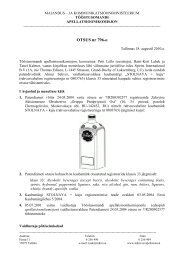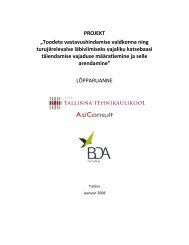Feasibility study for an Estonian Materials Technology Programme
Feasibility study for an Estonian Materials Technology Programme
Feasibility study for an Estonian Materials Technology Programme
You also want an ePaper? Increase the reach of your titles
YUMPU automatically turns print PDFs into web optimized ePapers that Google loves.
72<br />
<strong>Feasibility</strong> <strong>study</strong> <strong>for</strong> <strong>an</strong> Estoni<strong>an</strong> <strong>Materials</strong> <strong>Technology</strong> <strong>Programme</strong><br />
3. <strong>Materials</strong> technology abroad: co-operation <strong>an</strong>d competition<br />
According to the state-of-art review of the paper, there are a number of indicators that materials research will<br />
become a battle ground <strong>for</strong> delivering the benefits of industrial technologies:<br />
The EU is world-leading in adv<strong>an</strong>ced materials sales (~80% >US <strong>an</strong>d Jap<strong>an</strong>)<br />
Strategic investment by the US, Jap<strong>an</strong> <strong>an</strong>d China in materials research programmes are on a competitive<br />
level<br />
Strategic investment in large facilities by the US, EU, Jap<strong>an</strong> <strong>an</strong>d China to support materials research programmes<br />
Bibliometric studies of n<strong>an</strong>otechnology scientific publications<br />
Principle locus on industrial n<strong>an</strong>otechnology R&D investment<br />
Largest number of submissions to NMP calls per year in FP7<br />
In 2008, EU research spending on n<strong>an</strong>otechnology from all public sources was $2.6 billion (approx 30% of<br />
the world total). 78 The strongest n<strong>an</strong>otech public sector funding programmes are in Germ<strong>an</strong>y, Fr<strong>an</strong>ce <strong>an</strong>d<br />
the UK with Germ<strong>an</strong>y being the biggest with approximately 400 million Euros <strong>an</strong>nually (ref2). Private R&D<br />
investment amounts to only $1.7 billion in Europe compared to $2.7 in the US <strong>an</strong>d $2.8 billion in Asia. 79<br />
In Europe there is currently one Era-Net in materials technology working under the NMP-programme.<br />
Altogether 13 countries or regions are participating in this MATERA Era-net including Finl<strong>an</strong>d, Belgium, Spain,<br />
Pol<strong>an</strong>d, Israel, <strong>an</strong>d Latvia. MATERA offers particip<strong>an</strong>ts 1) a simplified way to initiate <strong>an</strong>d participate in R&D<br />
projects at the Europe<strong>an</strong> level 2) <strong>an</strong> opportunity to easily access international know-how 3) <strong>an</strong> opportunity<br />
to integrate into international value chains. Matera funds joint research projects of partners in the countries.<br />
Funding comes from the local governments, EU-funds the joint activities of the network. Altogether the<br />
Matera ERA-Net has launched six calls during its existence. The final call was in early 2011 with the goal to:<br />
launch tr<strong>an</strong>snational, interdisciplinary, innovative, R&D projects related to materials science <strong>an</strong>d engineering<br />
narrow the gap between basic materials research <strong>an</strong>d applied problems<br />
shorten the time-to-market of scientific outcomes<br />
3.2.8 Russia<br />
During the last 5-10 years, Russia has become signific<strong>an</strong>tly more active in the area of n<strong>an</strong>o <strong>an</strong>d adv<strong>an</strong>ced<br />
materials technologies. There is a huge research base available in the country <strong>an</strong>d the state is currently driving<br />
technology tr<strong>an</strong>sfer activities through org<strong>an</strong>isations such as RUSNANO. Russia has recently established<br />
several programmes <strong>for</strong> regulating the science <strong>an</strong>d technology development, two of which are most relev<strong>an</strong>t<br />
<strong>for</strong> materials sciences:<br />
National Technological Base (2007-2011)<br />
Development of N<strong>an</strong>oindustry Infrastructure in the Russi<strong>an</strong> Federation (2008-2010)<br />
These programmes together correspond to approximately 1.5 billion EUR of funding 79 <strong>an</strong>d in addition, RUS-<br />
NANO is investing close to 1 billion EUR <strong>an</strong>nual in n<strong>an</strong>otechnology industry development in Russia.<br />
N<strong>an</strong>otechnology has been identified as a key future technology in Russia <strong>an</strong>d it is in close relationship with<br />
materials technologies in e.g. RUSNANO projects. The projects fin<strong>an</strong>ced by RUSNANO are divided into 6 clusters<br />
with example projects similar to Estoni<strong>an</strong> competences:<br />
Solar energy <strong>an</strong>d energy efficiency<br />
Thin film solar p<strong>an</strong>els<br />
Lithium-ion batteries<br />
N<strong>an</strong>ostructured materials<br />
Novel light composite materials<br />
Flexible polymer packaging materials<br />
Medicine <strong>an</strong>d biotechnology<br />
Engineering <strong>an</strong>d metalworking<br />
Metal-cutting tools with n<strong>an</strong>ostructured coatings<br />
Wear-resist<strong>an</strong>t products made of n<strong>an</strong>ostructured ceramics <strong>an</strong>d metal<br />
N<strong>an</strong>ostructured non-metallic coatings<br />
78 NMP EXPERT ADVISORY GROUP (EAG) POSITION PAPER ON FUTURE RTD ACTIVITIES OF NMP FOR THE PERIOD 2010 – 2015<br />
79 Dmitry Filatov OECD presentation





